If you’re looking to serve up a show-stopping, mouth-watering turkey this holiday season, look no further than my Fried Turkey Recipe! We’re talkin’ about a turkey so succulent and juicy on the inside, and perfectly crispy on the outside, it’ll make you wonder why you ever bothered with oven roasting. Learn how to deep-fry a turkey to crispy, golden-brown skin and tender, juicy meat perfection! This bird is infused with a flavorful homemade injection and rubbed down in cajun seasoning, resulting in an out-of-this-world holiday experience!
This post may contain affiliate links. Read our disclosure policy.
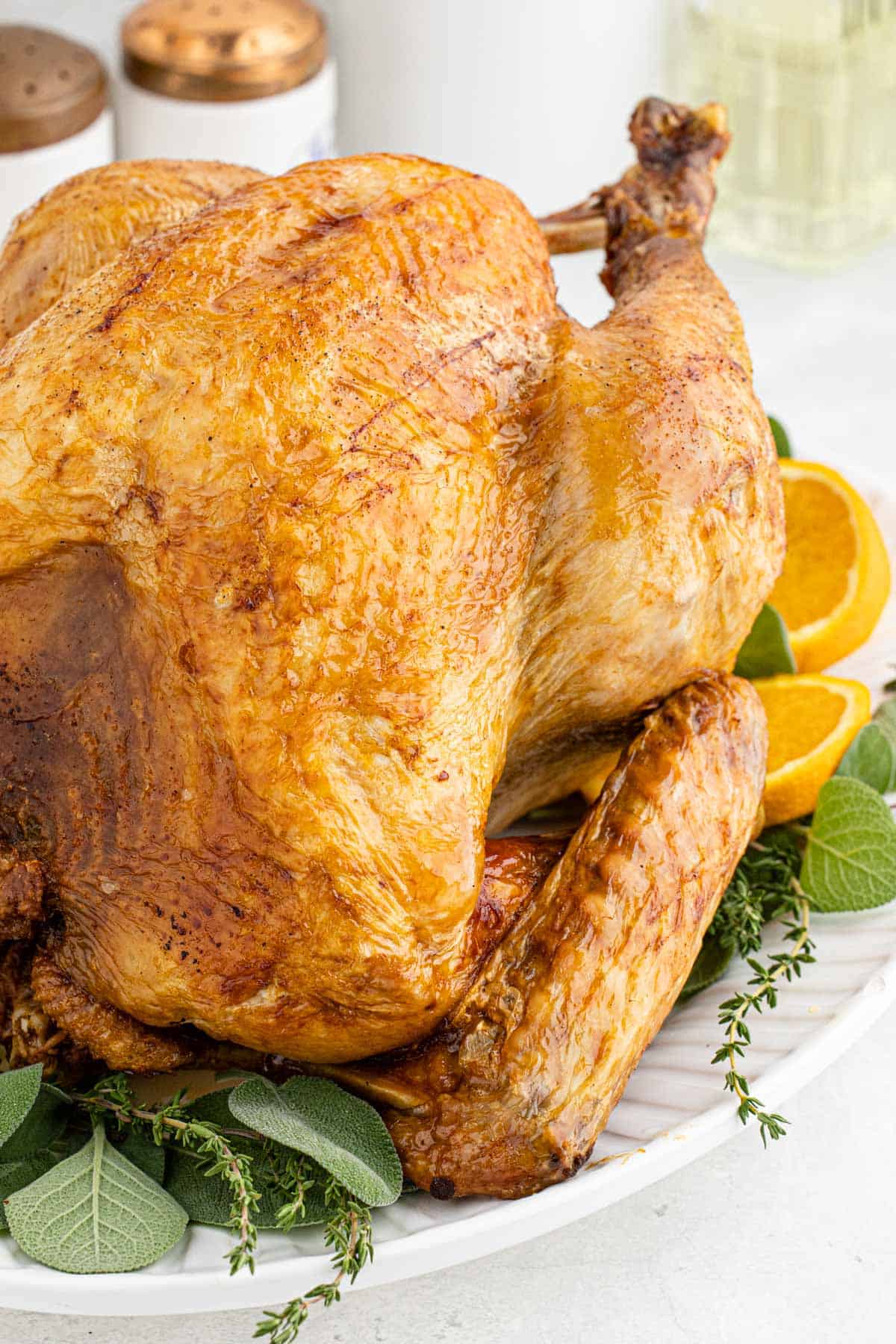
Want to Save This Recipe, Boo?
Drop your email below, and this delicious recipe will slide right into your inbox! Plus, you’ll get all the latest updates and goodies from Grandbaby Cakes.
My daddy has been frying our Thanksgiving and Christmas turkey for the last ten years. Once we had the first taste, we never went back. Now, I know deep-frying can sound intimidating, but don’t you worry; this guide is as much a “How-To” as it is a recipe. I’m gonna take you step-by-step through the process, including a homemade injection marinade that is so packed with flavor, it’ll make your taste buds dance!
The goodness doesn’t stop there. We’re not just frying any ol’ turkey; we’re elevating it with a blend of cajun spices that’ll bring a little Southern heat to your table. This recipe uses the king of oils—peanut oil—to get that crispy, golden exterior that’s signature to a well-fried turkey. So grab your apron and let’s get this party started, ’cause if you’ve been searchin’ for the ultimate fried turkey recipe, boo, you just hit the jackpot!
Whether you’re a fried turkey veteran or a newbie, this recipe is fun, friendly and oh so delicious. Happy Thanksgiving y’all!
Warning: Frying a turkey is an extremely dangerous undertaking. Yes, there are precautions that can be taken to minimize the risk but there’s no way to heat up gallons of oil, dunk a turkey in it and be guaranteed that you won’t hurt yourself or others. Be sure to follow the safety guidelines provided below.
Safety Guidelines You Should Follow For Deep Frying Turkey
As mentioned above, frying a turkey is not something to be taken lightly. To ensure your own safety and the safety of others, it’s crucial to not only prepare but to do everything possible to prevent disaster.
Let’s kick things off with a few critical points:
- Children and pets should be nowhere near a deep-frying setup. There should be absolutely no chance they’ll get anywhere close to it.
- Before frying, read and follow the manufacturer’s instructions and warnings included with your deep fryer. Regardless of what’s written in this post, it’s more important to adhere to those rules rather than deviate.
- I don’t recommend the use of indoor fryers, it’s a bit too risky for my taste. But, if an indoor setup is your only option, make sure it is indeed an indoor setup. An outdoor setup will not suffice inside and vice versa.
- Keep a fire extinguisher on hand! Seriously y’all, you never know.
- Wear protective clothing. I highly recommend wearing long sleeves (maybe even layers), protective gloves and close-toed shoes. Oil splatter burns are not fun.
- Once in the fryer, do not leave it unattended! If you need relief from cold weather or have to take a bathroom break, find someone to take your place.
- Most importantly, DO NOT DRINK AND FRY. I know, it’s Thanksgiving and we all deserve to drink and enjoy, but I promise it’s not worth the potential ruin.
Okay, now that we’ve covered the serious stuff, let’s talk deep-frying!
Why Deep Fry a Turkey?
Beware: if you’ve never had a fried turkey, you might never want an oven-roasted one ever again. Fried Turkeys can deliver an incredibly-juicy bird with the crispiest skin possible. Seriously, I’m talking about a potato chip outside with a tender, fall-apart inside!
Though frying a turkey won’t save you any time, it is a forgiving cooking method. Should you accidentally overcook your poultry, which I don’t recommend, it will still retain most of its juices. If you’re unsure as to whether or not this is the method for you, I suggest roasting a back-up bird. You can’t go wrong with extra day-after sandwich meat.
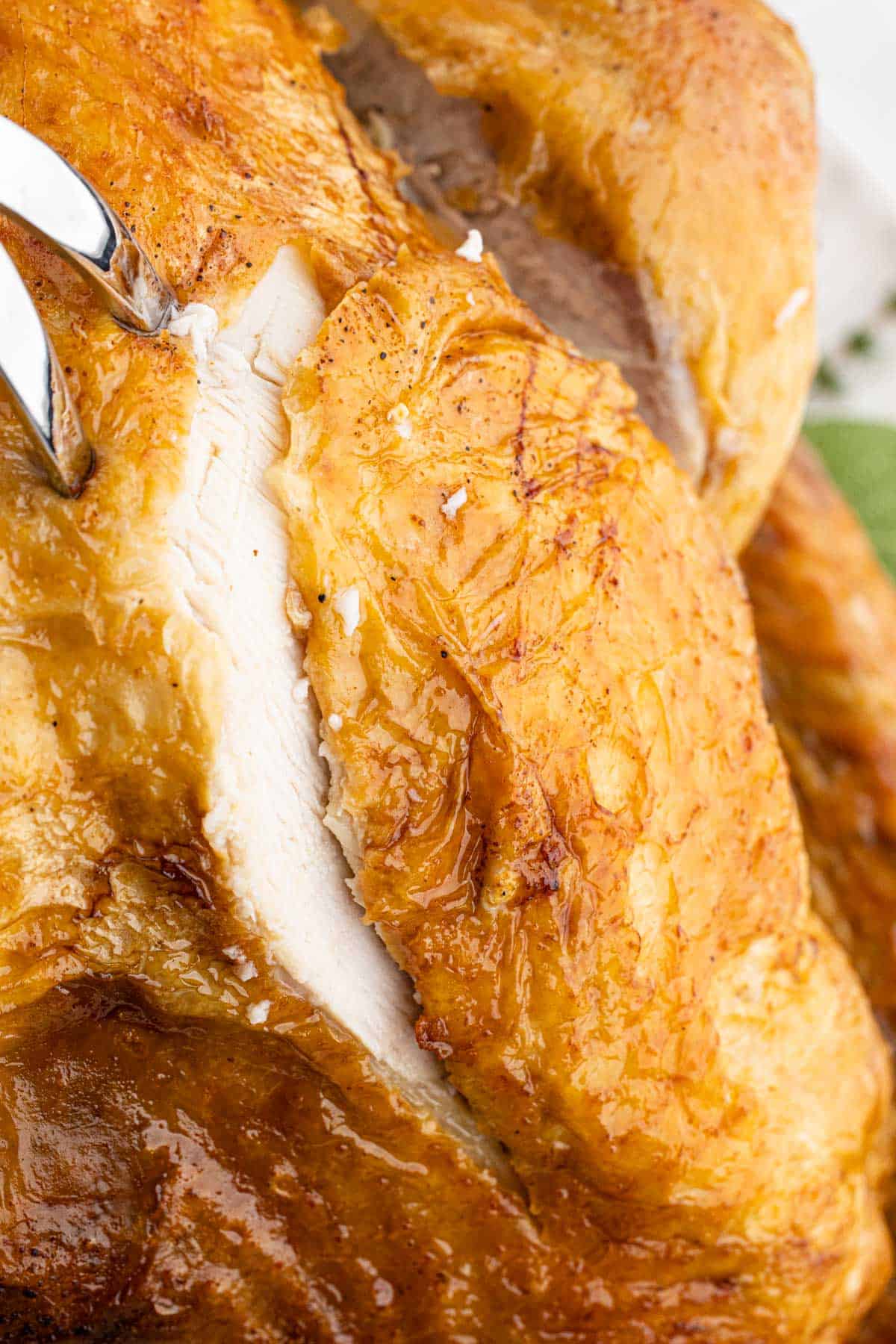
Ingredients
Now, you don’t have to make the injection recipe, but I highly recommend it. Putting the flavor straight into the meat makes a world of difference. If this is your first Thanksgiving or Christmas dinner with new in-laws or guests and you really want to blow their minds – don’t skip the injection!
For the Injection
- Chicken stock: The base of your marinade, this provides essential moisture and a hint of chicken flavor.
- Salted butter: Because everything tastes better with butter, especially when it’s adding rich, creamy notes.
- Light brown sugar: Adds a nuanced sweetness that balances the savory and spicy elements.
- Worcestershire sauce: A complex flavor booster with a little tang, a little sweet, and a lot of savory.
- Apple cider vinegar: A splash of acidity to wake up those flavors.
- Onion powder: For that essential aromatic backdrop.
- Garlic powder: Another aromatic that adds depth and a touch of spice.
- Lemon juice: Citrus brightens up the whole ensemble.
- Concentrated liquid crab boil: A Southern staple that adds a unique spicy and aromatic complexity.
- Soy sauce: An umami bomb that deepens the savory notes.
- Seasoned salt: A multi-spice blend that elevates the basic seasoning.
- Cajun seasoning: A mix of various spices that bring in that Southern kick.
- Cayenne pepper: Just enough to add a dash of heat.
For the Turkey
- Turkey: Go for high-quality, between 10 – 14 pounds and make sure it’s room temperature and fully thawed.
- Peanut oil: Essential for deep frying, it has a high smoke point and imparts a nutty, rich flavor.
- Cajun seasoning: A blend of spices that’ll add character and a Southern twist to your turkey’s skin.
How to Fry A Turkey Outside
Alright y’all, here’s where things get a bit serious again. Before your turkey gets anywhere near hot oil, you’ll need a foolproof frying-rig, which includes a burner and stand, a pot, a thermometer for the oil, and the hanger and lowering mechanism for the bird. You’ll also need a propane tank. You should NOT try to jury-rig your own setup.
The biggest mistakes people make when using this cooking method are: setting up the fryer in or near a home or something combustible, overfilling the pot with oil, and dropping the turkey too quickly, causing the hot oil to splash. Not fun.
To ensure a safe outdoor frying experience, follow the guidelines below:
- First, determine how much oil you need. To do that, place the turkey in the pot and fill it with water, measuring along the way. Stop when the turkey is covered by about half an inch or so. Remove the turkey and be sure to properly dry it.
- Once the turkey is removed, pour the water out of the pot, dry it well, then fill it with the equivalent amount of oil.
- Your setup should be in an open area, a safe distance away from anything flammable.
- Preheat the oil to 350 degrees (using a thermometer). Once the oil has reached its temperature, securely insert the hanger into the bird.
- Very carefully and slowly, lower the turkey into the pot. Ease the bird into the oil and, if it seems to go wrong on the way down, pull it out immediately and try again.
- Once the turkey is submerged, it will cook quickly. I’d recommend about 2-3 minutes of cooking per pound of meat.
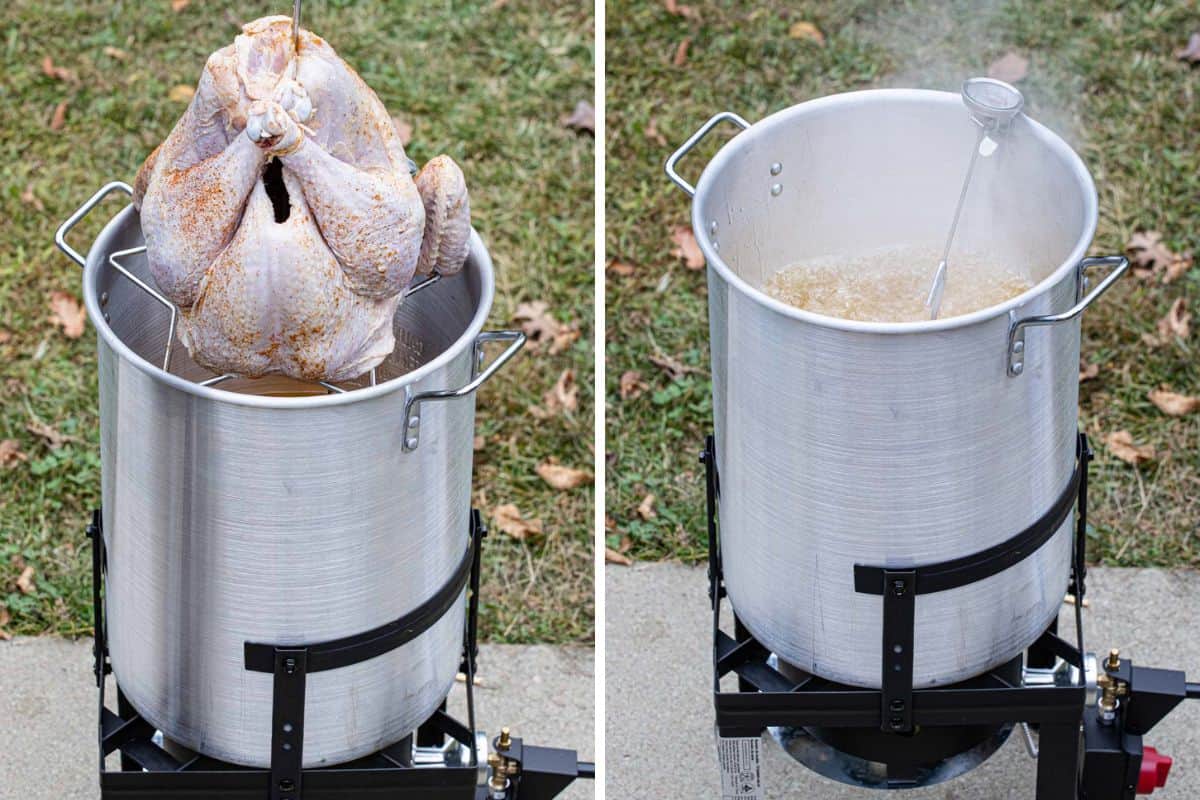
- When you’re ready to check the temperature, use the hook to slowly pull out the turkey, allowing for excess oil to drip off as you raise it.
- When the internal temperature of the turkey reaches 145 degrees, you’re good to go! Let it rest for at least 20 minutes before carving.
Voila! You’ve successfully fried a turkey! With this accomplishment comes full bragging rights, enjoy them.
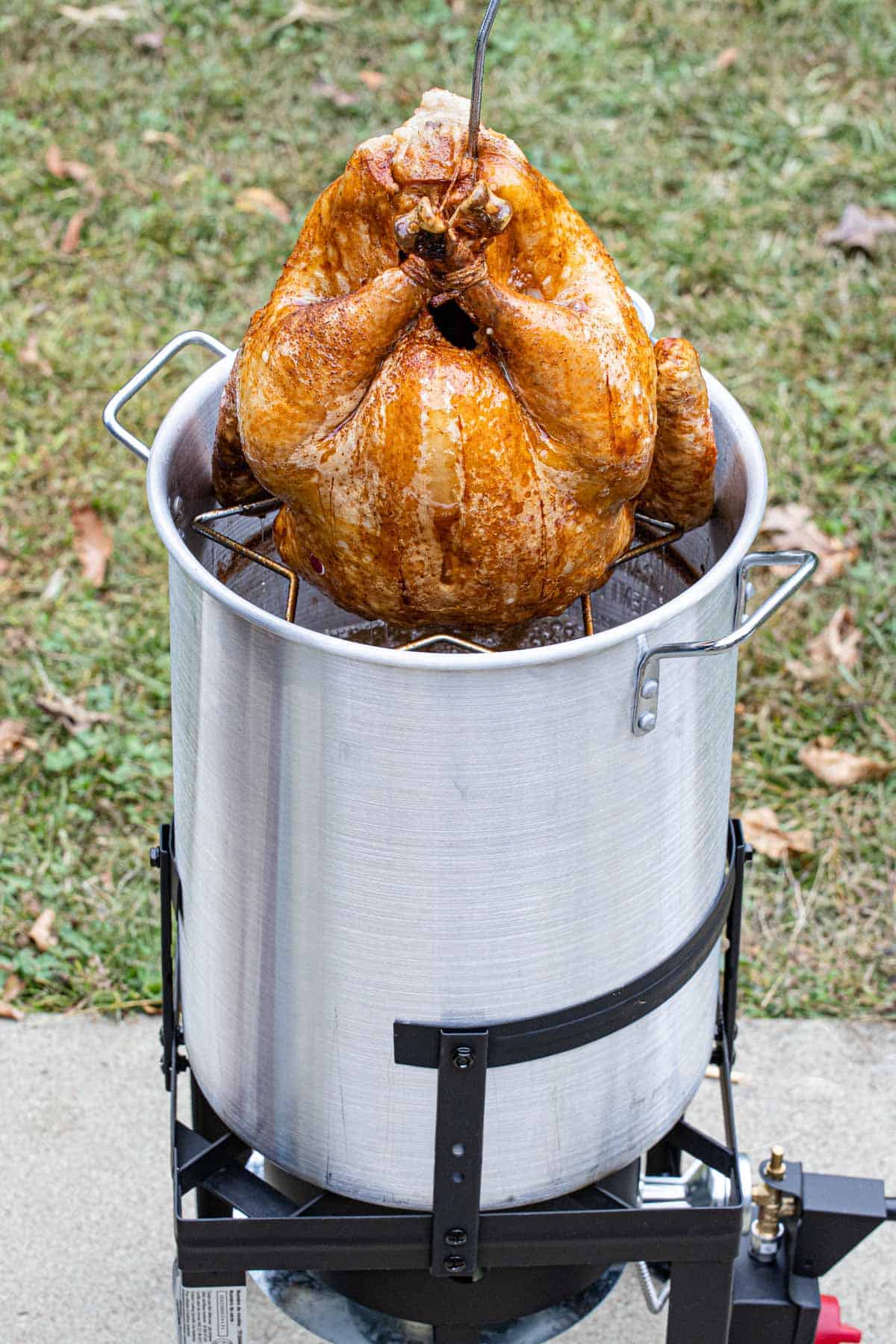
How to Fry A Turkey Inside
A lot of people don’t know that you can fry a turkey inside! Though I prefer the outdoor method, indoor turkey fryers are a great option for those who don’t have the outdoor space or those who live in cold climates. There are plenty of model options for you to choose from, just know that they are a bit more expensive than the outdoor variety.
To use, follow the instructions below:
- Pour oil into the fryer and begin to preheat to 350 degrees.
- Set the turkey in the fryer basket and, once the oil has preheated, carefully lower it into the hot oil.
- Follow the same cooking instructions above.
- When the turkey is done, carefully lift it out the fryer and allow it to rest before carving.
I’ve found that both the indoor and outdoor deep-frying methods produce a similar result. The cooking time is the same as well! So, the choice is really yours!
Tips for Making the Best Fried Turkey
- Quality Turkey: Start with a quality bird, y’all. The better the turkey, the better the end result. Make sure it’s fully thawed and at room temperature before you start the process.
- Injection Timing: Inject the marinade at least a few hours before frying, to let those flavors permeate the meat. If you can do it up to 24 hours ahead, even better!
- Dry it Well: Thoroughly pat dry the turkey inside and out before frying. Any extra moisture can cause that oil to act up, and we don’t want any splattering now, do we?
- Temperature Check: Monitor your oil temperature closely. Maintaining a consistent temp between 350°F and 375°F is key for a crispy exterior and juicy interior.
- Safety First: Never leave your fryer unattended, and make sure to set it up outdoors, away from any flammable objects. Safety goggles and long utensils are your friends.
- Season Generously: Don’t skimp on the seasoning, especially on the skin. It crisps up beautifully and that flavor should sing!
- Resting Time: Once your turkey is out of the oil, let it rest for at least 20 minutes before carving. This ensures all the juices get redistributed throughout the meat.
Substitutions & Additions
- For the Injection:
- Swap Out Butter: If you’re dairy-free or want a different profile, use a high-smoke-point oil like avocado oil instead of butter.
- Herbs and Spices: Feel like gettin’ fancy? Add some fresh thyme, rosemary, or even a little smoked paprika to your injection for an extra layer of flavor.
- For the Turkey:
- Seasoning Blends: If Cajun isn’t your thing, try a BBQ rub, lemon-pepper seasoning, or even a classic herbes de Provence.
- Oil Choices: If you’re allergic to peanuts or just want a different oil, canola or sunflower oil also work well, though they might slightly alter the flavor.
- Spice Level: Adjust the heat by playing with the amount of Cajun seasoning or cayenne pepper. Some like it hot, some not!
- Sweet and Tangy: A small amount of maple syrup or honey in the injection can balance out the spices with some sweetness.
- Fruit Juices: For a twist, try adding apple or orange juice to the injection. The natural sugars can caramelize nicely, giving you a slightly different flavor.
How to Serve
A turkey is a turkey! Serve this masterpiece with all your favorite Thanksgiving breads, puddings, mashes and greens. If you’re looking to make this a special Southern-inspired meal, cook up a few of my favorite family classics:
- Candied Sweet Potatoes
- Southern Macaroni and Cheese
- Southern Cornbread
- Sweet Potato Casserole
- Southern Collard Greens
- Southern Mustard Greens

How to Store Fried Turkey
- Short-Term: If you’ve got leftovers (and that’s a big if, ’cause this turkey is just that good), wrap ’em tightly in aluminum foil or plastic wrap. Place them in an airtight container and keep in the fridge. They’ll stay good for about 3 to 4 days.
- Freezing for Later: Got more turkey than you can handle? No worries! You can freeze this bird. Just make sure to remove the meat from the bones first. Wrap the turkey slices or pieces in aluminum foil and then put them into a freezer-safe plastic bag. Squeeze out as much air as you can before sealing. Your turkey will keep for up to 2-3 months in the freezer.
- How to Reheat: Whether it’s from the fridge or the freezer, you’ll want to reheat your turkey without drying it out. To do this, preheat your oven to 325°F. Place the turkey in an oven-safe dish and cover it with aluminum foil to keep it moist. Heat until the internal temperature reaches 165°F. If it’s from the freezer, thaw in the fridge overnight before reheating.
Frequently Asked Questions
HOW BIG OF A TURKEY CAN I FRY?
Most indoor and outdoor fryers boast about being able to handle up to an 18-pound turkey but I wouldn’t recommend going THAT hard. Smaller birds cook more evenly, and frying a large one increases the risk of burning the skin before the center cooks through. Large birds can also cause oil-spillover, even if you’ve properly measured the oil and have it below the maximum fill-line on the pot.
I would suggest staying under a 15-pound turkey in fryers that claim an 18-pound maximum.
SHOULD I FULLY DEFROST MY TURKEY?
YES! Placing a wet or icy turkey in hot oil could land you in the hospital, especially if there are chunks of ice. As a general rule, turkey-thawing time in the fridge requires about 24 hours for every 5 pounds ( in a refrigerator set to about 40 degrees).
Pay extra attention to this: a seemingly full defrosted turkey might still be hiding ice in its cavity, especially between the rib bones. Double, triple and quadruple-check that there is no ice hidden in there, and dry the bird well before putting it in the hot oil.
IS IT WORTH IT TO MAKE A HOMEMADE TURKEY INJECTION?
Absolutely! In fact, I’d even say that it’s necessary! Injecting turkey is a method that flavors meat from the inside, tenderizing it while slowly spreading the flavors through the bird. Injection marinades can be used with traditional turkey marinades, turkey rubs, and even turkey brines.
For this recipe, I used my daddy’s signature homemade injection. Made with a mixture of carefully chosen spices and liquid flavorings, this injection is beyond anything you’ve ever tasted before. Salty, sweet, spicy and well-balanced, this simple concoction imparts an astounding amount of flavor in our bird. Trust me, after about 10 years of successful testing, I can confidently guarantee that this injection is IT.
What Kind of Frying Oil Should I use?
Peanut oil is the best oil for deep-frying turkey, as its high flash point makes it less likely to catch on fire. The best oil for fried turkey should be low in saturated fat so that the turkey absorbs the least amount of oil as possible. Vegetable oil is an alternative but I highly recommend sticking to the peanut variety.
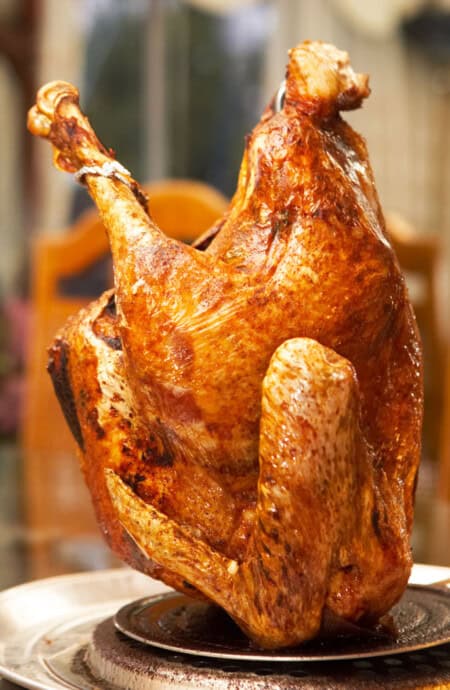
Fried Turkey Injection
Email This Recipe
Enter your email and this recipe will arrive in your inbox! You’ll also get updates on the latest posts and more from Grandbaby Cakes.
Equipment
Ingredients
For the Injection
- 1 cup chicken stock
- 3/4 cup salted butter melted
- 4 tbsp light brown sugar packed
- 4 tbsp worcestershire sauce
- 2 tbsp apple cider vinegar
- 2 tbsp onion powder
- 2 tbsp garlic powder
- 2 tbsp lemon juice
- 1 tbsp concentrated liquid crab boil
- 1 tbsp soy sauce
- 2 tsp seasoned salt
- 1 tsp cajun seasoning
- 1/4 tsp cayenne pepper
For the Turkey
- 1 turkey 10-14 lb, room temperature
- 3-5 gallons peanut oil
- cajun seasoning- can be store bought or turkey spice
Instructions
For the Injection
- Add all ingredients to a small pot over medium heat and simmer for 30 minutes until slightly reduced.
- Allow injection to come to room temperature and add to a injector.
For the Turkey
- Clean the turkey thoroughly inside and out.
- Once the turkey is completely thawed out and room temperature, place injection needle all over turkey particularly in meaty areas like breasts and thighs and inject liquid inside of turkey. If some comes out, just rub on the outside. (2-3 injections per thigh and 3-4 per breast should be good but the more the merrier if you want more flavor). Allow marinade to sit up to 24 hours.
- The longer the better!
- Thoroughly sprinkle the turkey with cajun seasoning and rub in.
Notes
- Heat oil in a very large stockpot to 350 degrees. Once heat reaches temperature, insert hanger into turkey. It should be very secure.
- Slowly and carefully lower turkey into oil until fully submerged. Fry turkey about 3 minutes per pound but start checking sooner just in case.
- Turkey should reach an internal temperature of 145 degrees so when you check with your thermometer it should reach this temp.
- Once there, remove and allow to rest for at least 20-25 minutes.
I have never fried a turkey before but this looks amazing. The flavour for the injection are perfect and it looks so easy too to get that lovely crispy skin.
Your Fried Turkey Recipe is an absolute game-changer for holiday feasts! The description alone has my taste buds tingling with anticipation. The promise of a succulent, juicy interior combined with a perfectly crispy exterior is enough to make anyone’s mouth water.
OH MY WORD…..just fried our 18.27 lb turkey with your recipe and I AM IN LOVE. This will be our official way of serving a turkey moving forward. THANK YOUR Dad for sharing his recipe!! 🙂 HAPPY THANKSGIVING!!!
I fried my Turkey for the first time last year. I used a different inject and dry rub recipe but came looking for a new one and I found it! Will update after Thursday 🙂
This is a great recipe! I have never fried a turkey before, but this was really easy and it came out great!
Great job! Amazingly easy to follow article with all the important safety points! We are going for it again this Christmas after frying our first bird at Thanksgiving. Thanks for the delicious tips.
Mine turned out really dark it looks burnt. Is this normal? I followed everything to the T
No it shouldn’t be burnt unless your oil was too hot and it cooked for too long?
Is the injection supposed to be thick or liquidy?
It should be liquidy enough to go through the needle into the turkey.
Is the turkey injection recipe good to use as is if we are cooking turkey in the oven?
Yes you could definitely still use it.
This is a super tasty recipe and is great for those who fry turkeys for outdoor parties!